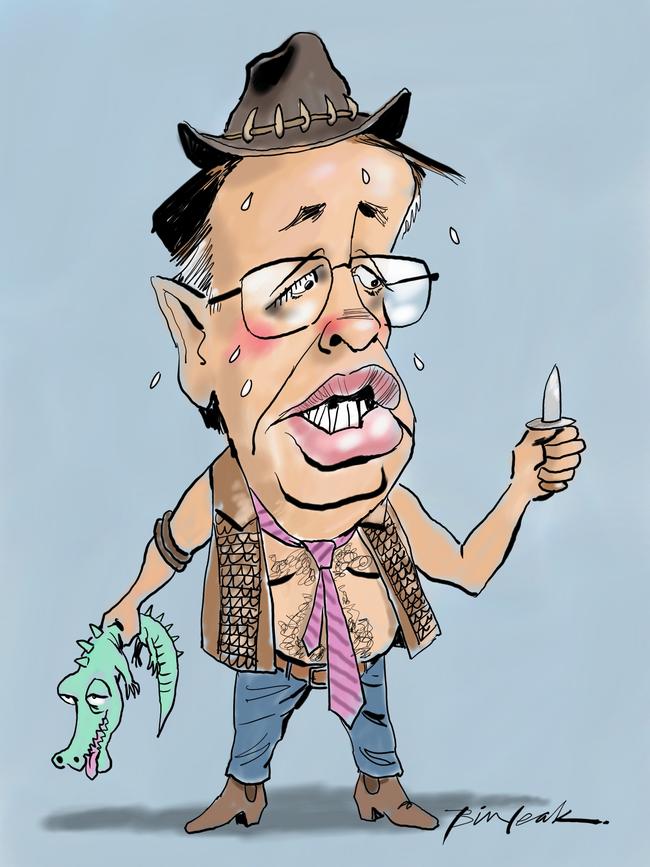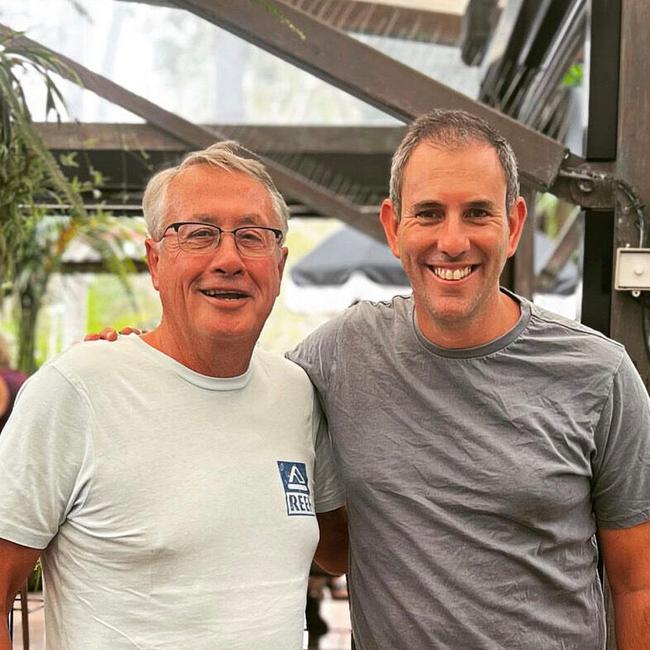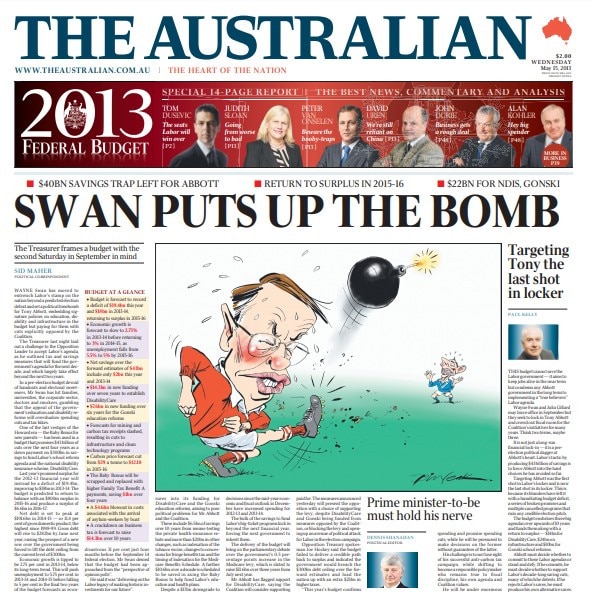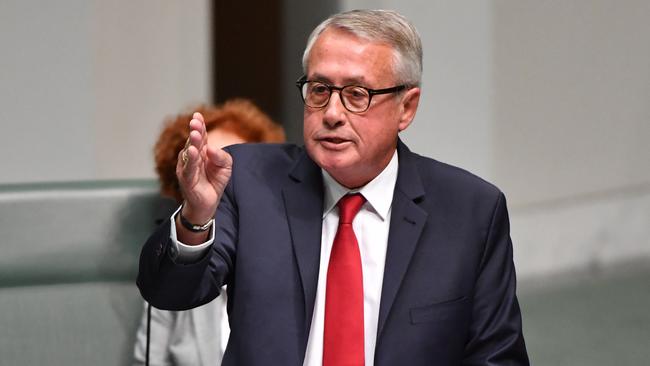
Originally this was to prevent reporters from capitalising on inside knowledge that might move financial markets. Nowadays budgets are so comprehensively leaked the only reason to continue with lock-ups is to try to influence media coverage.

Back in the Gillard years – during which time I was editor-in-chief of The Australian – I phoned my cartoonist, the late great Bill Leak, at 7.31pm at his home on the NSW central coast to discuss a page one cartoon that might reflect the actual content of that 2011 budget.
Treasurer Wayne Swan had promised tough spending cuts after the blowouts under Kevin Rudd during the 2008-09 Global Financial Crisis. We did not think Swan had delivered.
An hour later Bill emailed a rough drawing of Swan as Crocodile Dundee with a small oyster shucker in one hand and a toy crocodile in the other. The page one headline read: “That’s not a knife, Treasurer”.
Present Labor Treasurer Jim Chalmers was Swan’s chief of staff. Like Swan and Rudd, Chalmers kicked off as Treasurer by writing a long essay about making capitalism kinder. The original Labor model for such posturing was former Labor opposition leader Mark Latham, who in 1998 wrote a whole book on the issue, titled, Civilising Global Capital.
The country was lucky to dodge Latham, but not so lucky with Rudd, Swan and Chalmers who all thought themselves “economic seers” but never achieved the reforms of previous treasurers, Paul Keating or Peter Costello.
Partly paraphrasing economics Professor Richard Holden in The Australian Financial Review on January 2, Chalmers (and in this column’s view Rudd and Swan) fought the laws (of economics) but the laws won.

In Rudd’s case it was huge spending to prevent a GFC-induced recession Australia was never going to have because of the revenue boom flowing from coal and iron ore sales to China.
Swan in 2012 announced four surpluses that became large deficits. Then, in 2013, ahead of an election Labor expected to lose to opposition leader Tony Abbott, Swan’s budget included the greatest Labor debt bomb of the past two decades: the National Disability Insurance Scheme, that is set to cost $100bn a year by the middle of the century.

In addition to the NDIS, that last Swan budget included projected funding for 10 years of Gillard’s Gonski education reforms, paid for with cuts that Labor knew Abbott would find unpalatable.
Leak that year drew Swan in a Queensland Reds jersey kicking a debt bomb rather than a rugby ball to Abbott in a blue NSW jersey. Chalmers too is kicking the national debt down the road: MYEFO in December predicted a deficit of $27bn and no return to balance for a decade.
Chalmers’ Future Made in Australia plans, government underwriting of private sector wages in aged care and childcare, and the extension of childcare subsidies to families earning as much as $530,000 a year all contribute to exploding government debt.
On Friday, Clare Armstrong in the News Corp tabloids reported most of the childcare subsidy increase introduced in September 2023 had already been eaten up by fee rises, just as this column predicted.
Chalmers has presided over record growth in federal and state public service job creation. He has run expansionary fiscal policy that he says shows Australia can beat inflation without destroying jobs.
Never mind per capita incomes have been in recession for a record seven consecutive quarters. Or that without more than a million migrants in two years the nation would be in recession.
Chalmers and his Prime Minister, Anthony Albanese, have used public spending to avoid being tossed out of office after only one term. Just as both did when part of the first Rudd government 15 years earlier.

Yet, despite the fall in inflation revealed last Wednesday, it is not clear a single 0.25 per cent rate cut in February, which is no certainty, will save Albo.
Economist Steven Hamilton, writing in The Australian Financial Review on December 8, nailed the problem: prosperity is driven by the private sector.
Hamilton argued there were now two economies in Australia: the very sick private sector (“Consumption went backwards over the past six months. Investment has ground to a halt. Employment growth is anaemic.”) and the parasitic healthy public sector economy “that is sucking the life out of” the private economy.
In the public economy, “consumption has grown 10 times faster than in the (private) economy. Investment is at its fastest in six years. Employment growth is at its fastest in at least 30 years outside the pandemic”.
Disputing Chalmers’ claim that without this public spending the economy would be worse, Hamilton explained, “what’s missing from the Treasurer’s (analysis) is that, had he and his state colleagues showed a modicum of restraint over the past two-and-a-half years, interest rates would be lower (now)”, stimulating private sector activity and employment.
While unemployment is low at 4 per cent, 87 per cent of all jobs growth in the past two years has been in the non-market sector – many in the NDIS, aged care and child care.
Add to that the deliberate wage rises engineered by former industrial relations minister Tony Burke. Figures released on November 7 show the number of federal public servants rose 3.6 per cent in the year to June 30 and their wages climbed eight per cent to $232bn.
Still Chalmers claims things are better here than overseas. Is he right?
Chalmers believes in a new world driven by the opportunities of power price falls from renewable energy and the growth of the care economy. He sees government at the centre of the economy – a European social democratic model.
But as Judith Sloan wrote in The Australian on January 15, Europe is in trouble. Its engine room, Germany, is in recession largely because, like our government, it has plunged headlong into renewable energy, losing its comparative advantage in manufacturing to China.
Yet the US, where capitalism and fossil fuels are about to be turbocharged by President Donald Trump, boasts “median disposable income … 25 per cent higher than in Germany and 60 per cent higher than in Italy”, Sloan wrote.
Productivity is surging in the US, but in the doldrums in Australia, Germany and France.
On most measures – growth, unemployment, productivity and business investment – US capitalism is proving much more resilient than Labor’s essayists foresaw.
Apparently open economies, free markets and deregulated wages work well to allocate scarce resources. Who knew?
After gloating about two surpluses entirely built on record revenue from mining exports, Chalmers is going to have to spin hard to make the budget look good next month.
He and Albanese are making the same mistakes Rudd and Gillard did – minus the public leadership instability. Voters wanting prosperity need to hope they don’t do a deal with the Greens to form majority government the way Gillard did in 2010.







Informed readers know media coverage of the annual federal budget involves “locking up” journalists inside Parliament House without their phones or computer access to the outside world until the Treasurer begins his budget speech at 7.30pm.